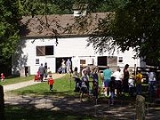
Chellberg Farm
Encyclopedia
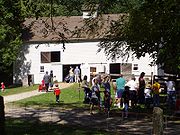
Indiana Dunes National Lakeshore
Indiana Dunes National Lakeshore is a U.S. National Lakeshore located in northwest Indiana and managed by the National Park Service. It was authorized by Congress in 1966. The national lakeshore runs for nearly along the southern shore of Lake Michigan, from Gary, Indiana, on the west to Michigan...
. Chellberg Farm is significant as it represents the ethnic heritage of a nearly forgotten Swedish-American settlement. The farm includes a family home, water house with windmill, chicken coop/bunkhouse, and the original barn. Other nearby Swedish landmarks have been restored or preserved, including the Burstrom Chapel and the Burstrom Cemetery.
Swedish Community
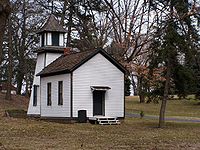
Porter County, Indiana
Porter County is a county located in the U.S. state of Indiana. As of 2010, the population was 164,343. Much of the population growth has to do with the expansion of the Chicago Metropolitan Area eastward into Indiana. The county seat is Valparaiso...
for several reasons, one being that there were new jobs available, another because like most immigrants, they sought out others like themselves. Baillytown's proximity to Chicago
Chicago
Chicago is the largest city in the US state of Illinois. With nearly 2.7 million residents, it is the most populous city in the Midwestern United States and the third most populous in the US, after New York City and Los Angeles...
connected it to the larger paths of Swedish immigration from the 1840s to the 1920s. The railroad came to the region in the 1850s and it provided for settlement and the transport of lumber from the lakeshore. A local story has it that an earlier Swedish immigrant, Jonas Asp, aided Joel Wicker in recruiting Swedes, including the Kjellberg family to work his lands. These settlers then encouraged friends and families to join them. The immigrants provided the necessary labor force for developing farmland, railroads, and industry in the area. The close-knit Swedish-American community emphasized their cultural heritage, teaching their children Swedish, establishing Swedish churches, and participating in social events where Swedish traditions were observed.
The Farmhouse
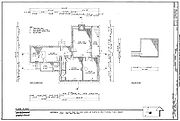
Victorian architecture
The term Victorian architecture refers collectively to several architectural styles employed predominantly during the middle and late 19th century. The period that it indicates may slightly overlap the actual reign, 20 June 1837 – 22 January 1901, of Queen Victoria. This represents the British and...
. This was a common style across the United States at the end of the 19th Century. The original structures was built on the 'T-shaped plan'. A two-story gable abutted a one-story wing. This created a location for a porch addition in the L between the gabled section and the wing. There may have been a second porch on the west side before the '1901' kitchen addition was added. Unlike many houses of this time, ornamentation was restrained. The house included a parlor, plenty of bedrooms and the kitchen. Overtime, a craftsman
American Craftsman
The American Craftsman Style, or the American Arts and Crafts Movement, is an American domestic architectural, interior design, landscape design, applied arts, and decorative arts style and lifestyle philosophy that began in the last years of the 19th century. As a comprehensive design and art...
fireplace was added in the dining room and later a glass-enclosed front porch. The glass enclosure was removed during rehabilitation.
Like many structures in this area, local labor and local materials were put to good use. The clay soils were turned into a thriving brick industry. the red brick facade is made of porter brick.
The Barn
Built over 130 years ago, the barn remains intact. Like its neighbors, the Chellberg barn is located north of the main house. It was built between 1870 and 1879, using a design common for that time. The 1880 census showed the Chellbergs having 'two milk cows, six other cattle, two sheep and five horses.' Over the years, the use of the barn changed and so did its design. By the 1900s, the family was operating a dairy farm. It is believed that the windows were installed during this period to improve light and ventilation. In 1917, a silo was added to provide for silageSilage
Silage is fermented, high-moisture fodder that can be fed to ruminants or used as a biofuel feedstock for anaerobic digesters. It is fermented and stored in a process called ensiling or silaging, and is usually made from grass crops, including corn , sorghum or other cereals, using the entire...
.
The barn is a three-bay structure with a gabled roof. It is 50.67 feet (15.4 m) by 24.25 feet (7.4 m), standing 25 feet (7.6 m) tall. The construction is on four bents
Bent (structural)
A bent is a framework composed of several structural members that defines the cross-section of a timber frame building or supports a trestle. The term bent is probably an archaic past tense of the verb to bind, referring to the way the timbers of a bent are joined together...
built using two 8 inches (20.3 cm) by 8 inches (20.3 cm) uprights. Two bents form the east and west ends, with the remaining two bents forming the center bay. The wood consists of a mix of oak, elm, ash, maple and basswood. Originally built on stone piers, Carl Chellberg added a concrete floor in 1938. The barn is located in an east-west alignment to provide maximum sun on the structure. It is also adjacent to the wood ravine, which helps block the winter winds.
Corncrib
The current corncrib was built in 1941, designed and built by Carl Chellberg. Over the years, the Chellbergs had several different types of corncribs. Originally, the farm had a drive-through corncrib, which gave way to the silo during the dairy farm period. The current crib is a single storage structure located just north of the house. The orientation is north and south apparently to conform to the property limited space. The existing structure is built on concrete piles to repel rodents. Large squared timber beams are placed atop these posts and then floored using tongue and groove flooring, which was taken from the silo. In the silo, the flooring ran up and down the structure. For this structure, the boards were split in half and cut to the necessary length and laid horizontally. At a later date, a wire mesh was placed on the inside of the walls for better protection from pests.The south wall of the shed was shared with a tractor shed, which is now gone. The tractor shed housed the Chellbergs' 1939 Allis-Chalmers
Allis-Chalmers
The Allis-Chalmers Manufacturing Co. of West Allis, Wisconsin, is an American company known for its past as a manufacturer with diverse interests, perhaps most famous for their bright Persian Orange farm tractors...
tractor. Once the tractor arrived, it was used instead of the horses for the harvest.
The Family
The Kjellberg Arrival in AmericaAnders Ludwig Kjellberg (born March 22, 1830) and Johanna (Anderson) Kjellberg (born April 28, 1829) were married in Sweden in the 1850s. They emigrated to the U.S. in 1863 with their son, Carl (born 1859). Family tradition says that they immediately moved to the Bailly area. They did not set up a home on the current location. They first lived on Mineral Springs road, south of the tracks from the Swedish Lutheran Church.
The 1871 Great Chicago Fire destroyed much of the Swedish community in Chicago
Chicago
Chicago is the largest city in the US state of Illinois. With nearly 2.7 million residents, it is the most populous city in the Midwestern United States and the third most populous in the US, after New York City and Los Angeles...
. Many Swedish residents choose to move to the Swedish community of Indiana. A popular story that is the Kjellberg family met Joel Wicker (the son-in-law of Joseph Bailly
Joseph Bailly
Joseph Bailly was a fur trader and a member of an important French Canadian family that included his uncle, Charles-François Bailly de Messein....
) while in Chicago and that Joel hired Anders to clean out brush in preparation for planting. Joel is said to have provided a small log house for the family.
Anders Kjellherg had been a tailor and a lay preacher the Lutheran Church in Sweden. He continued to place an emphasis on his religion after immigrating and helped to establish the Swedish Lutheran Church, now the Augsberg Lutheran Church. The Kjellbergs' second child, Carolyn, was born in the mid 1860's. She died at the age of three or four. The family also had a foster son, Simon Larson, who was born in 1874 and joined the family before 1880.
Arrival in Northwest Indiana
In October 1869 the family took legal title to the Chellberg Farm property. On November 1, 1869 the Kjellberg (Chellberg) family took possession of what is known as the Chellberg Farm. John Oherg and Anders Kjellberg represented the family in the purchase of 80 acres (323,748.8 m²) from J. H. Wicker. It cost $12.00 per acre. They also paid off an older contract of Wicker's worth $1000.
There were no structures on the land, nor was it cleared for agricultural use. The 1870 Population and Agricultural Census. The family of four living on the property with only 4 acres (16,187.4 m²) of improved land. No crops had been produce in their first year, but they had several animals, two milk cows, two other cattle and two swine. Their only farm production and possibly only source of income was 100 pounds of butter that had been produced. Meanwhile John Oberg’s farm also had 4 acres (16,187.4 m²) improved and a higher production level, 10 bushels of Spring wheat, 25 bushels of Winter wheat adn1 bushels of Irish potatoes. The Obergs owned one swine, two milk cows and had produced 150 pounds of butter. There appears to be some confusion over whether the Chellbergs were actually on the ‘farm site’ or if it was the Obergs who were residents at the time of the census.
Clearing the land would have been a slow process. In a good year, they might be able to clear only 15 acres (60,702.9 m²) per year. It’s more likely that they only cleared 5 acres (20,234.3 m²) to 10 acres (40,468.6 m²) a year. Clearing the land would produce sell-able lumber and cordwood, i.e., firewood. Most farms in the area were small and did a little of everything. The Chellbergs had an orchard which may have produced apples, pears, peaches, plums, cherries, grapes, strawberries, and raspberries.
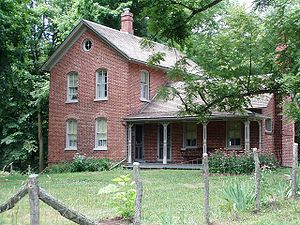
The construction of the brick farmhouse in 1885 was a major addition to the farm. For many families the construction of a new, larger house would have indicated an improved level of prosperity, however, the Chellberg farmhouse was constructed as a direct result of the disastrous fire that consumed the original family home. The use of brick for the new house was more likely to be an attempt to guarantee that another fire would not threaten the family, than a display of a new level of wealth
Second Generation at the Chellberg Farm, 1893–1908
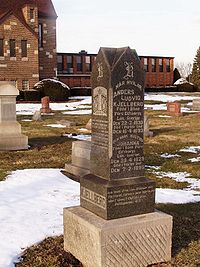
United States Department of Agriculture
The United States Department of Agriculture is the United States federal executive department responsible for developing and executing U.S. federal government policy on farming, agriculture, and food...
Farmer's Bulletins.
It is likely that C. L. Chellberg was in the process of developing the herd in 1901. After Emily Kjellberg married Alfred Borg in 1897, she and Alfred continued to live at the farm with their two children until 1901. Alfred was a carpenter and brick worker by trade so; he may have provided cash income by working off of the farm. In 1899 Johanna Kjellberg died at the age of 70. C. L. Chellberg and Emily and Alfred Borg continued to live in the farmhouse together until C. L. married Ottomina in 1901. Then, Emily and Alfred, with their children moved away. They lived with other relatives until ca. 1904 their home, Oak Hill Road and a ravine from the farm was completed.
Chellberg Dairy Farm, 1908–1937
By 1908 the Chellbergs had switched from grain production to dairy and grain farm. The Chicago, South Bend and South Shore Railroad
South Shore Line (NICTD)
The South Shore Line is an electrically powered interurban commuter rail line operated by the Northern Indiana Commuter Transportation District between Millennium Station in downtown Chicago and the South Bend Regional Airport in South Bend, Indiana...
had been completed and a stop was only a mile away. With the daily train, they could sell milk
Milk
Milk is a white liquid produced by the mammary glands of mammals. It is the primary source of nutrition for young mammals before they are able to digest other types of food. Early-lactation milk contains colostrum, which carries the mother's antibodies to the baby and can reduce the risk of many...
to the dairy
Dairy
A dairy is a business enterprise established for the harvesting of animal milk—mostly from cows or goats, but also from buffalo, sheep, horses or camels —for human consumption. A dairy is typically located on a dedicated dairy farm or section of a multi-purpose farm that is concerned...
in East Chicago. Over the following years, the children of C.L. and Ottomina (Naomi and Carl) and their children continued to work on the farm. Naomi (1907–1988), moved away from the farm only after her marriage to Alden Studebaker
Studebaker
Studebaker Corporation was a United States wagon and automobile manufacturer based in South Bend, Indiana. Founded in 1852 and incorporated in 1868 under the name of the Studebaker Brothers Manufacturing Company, the company was originally a producer of wagons for farmers, miners, and the...
in 1926. Even the grand children, Ann Chellberg Medley, daughter of Carl and Hilda Chellberg and Henry Studebaker and Arthur Studebaker, sons of Naomi Chellberg Studebaker and Alden Studebaker spent much of their childhood on the farm. Somewhere between 1920 and the 1930s, the dairy operation. It may have been when the South Shore closed its stop near farm or slowly over time as it became more difficult to get the milk to the train each day.
Third Generation at the Chellberg Farm, 1937–1972
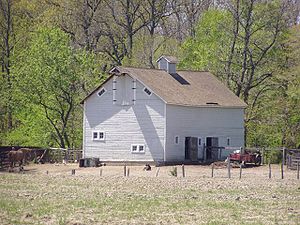
In 1938, Carl married Hilda Johnson. They had two children. The remodeled second floor of the farmhouse was an apartment where they and children lived. Minnie Chellberg died on November 15, 1952 at the age of 82. Minnie managed the house gardens, both the v vegetable garden and the flowers in the front yard. She also oversaw the orchard. She also continued to raise chickens.
Sometime in the 1940s Carl Chellberg began raising sheep and kept about 60 head. The sheep were sold at auctions for meat. The sheep grazed throughout the entire farm property and were kept in two sheep sheds that were constructed during this period. A large extension was built onto the south side of the barn in 1954. It was constructed by Carl Chellberg, Henry Studebaker, and Arthur Studebaker. Another sheep shed was constructed behind the granary. The building was smaller than the barn addition and constructed of corrugated iron. Eventually (sometime in the mid to late 1950s) Carl Chellberg took a job a machine shop in Chesterton and sold the sheep. Hilda Johnson Chellberg worked as a cook at a local restaurant. Once both Carl and Hilda had jobs off of the farm, the farm operation became a secondary effort and no longer the main family business."
Circa 1940 electricity was reestablished at the farm. It was used until the utility company power was brought to the farm in the 1940s after the war. During 1943, 1944, and 1945, Henry and Arthur Studebaker grew vegetables at the farm for sale to local residents. They had a 2 acres (8,093.7 m²) garden in the eastern portion of the field south of the orchard and north of the current visitor center parking lot. They grew vegetables to sell door to door in Dune Acres. They grew asparagus
Asparagus
Asparagus officinalis is a spring vegetable, a flowering perennialplant species in the genus Asparagus. It was once classified in the lily family, like its Allium cousins, onions and garlic, but the Liliaceae have been split and the onion-like plants are now in the family Amaryllidaceae and...
, lima beans, yellow and green snap beans, beets, broccoli
Broccoli
Broccoli is a plant in the cabbage family, whose large flower head is used as a vegetable.-General:The word broccoli, from the Italian plural of , refers to "the flowering top of a cabbage"....
, cabbage
Cabbage
Cabbage is a popular cultivar of the species Brassica oleracea Linne of the Family Brassicaceae and is a leafy green vegetable...
, carrots, cauliflower
Cauliflower
Cauliflower is one of several vegetables in the species Brassica oleracea, in the family Brassicaceae. It is an annual plant that reproduces by seed...
, celery
Celery
Apium graveolens is a plant species in the family Apiaceae commonly known as celery or celeriac , depending on whether the petioles or roots are eaten: celery refers to the former and celeriac to the latter. Apium graveolens grows to 1 m tall...
(white), kale
Kale
Kale is very high in beta carotene, vitamin K, vitamin C, lutein, zeaxanthin, and reasonably rich in calcium. Kale, as with broccoli and other brassicas, contains sulforaphane , a chemical with potent anti-cancer properties. Boiling decreases the level of sulforaphane; however, steaming,...
, leaf lettuce
Lettuce
Lettuce is a temperate annual or biennial plant of the daisy family Asteraceae. It is most often grown as a leaf vegetable. It is eaten either raw, notably in salads, sandwiches, hamburgers, tacos, and many other dishes, or cooked, as in Chinese cuisine in which the stem becomes just as important...
, endive
Endive
Endive , Cichorium endivia, is a leaf vegetable belonging to the daisy family. Endive can be cooked or used raw in salads.-Background:Endive is also a common name for some types of chicory...
, cantaloupe
Cantaloupe
"Rockmelon" redirects here, for the band see Rockmelons. See also Cantaloupe .Cantaloupe refers to a variety of Cucumis melo, a species in the family Cucurbitaceae which includes nearly all melons and squashes. Cantaloupes range in size from...
, watermelons, okra
Okra
Okra is a flowering plant in the mallow family. It is valued for its edible green seed pods. The geographical origin of okra is disputed, with supporters of South Asian, Ethiopian and West African origins...
, green onions, leeks, parsnips, peas, green and red peppers
Bell pepper
Bell pepper, also known as sweet pepper or a pepper and capsicum , is a cultivar group of the species Capsicum annuum . Cultivars of the plant produce fruits in different colors, including red, yellow, orange and green. Bell peppers are sometimes grouped with less pungent pepper varieties as...
, red, white, and sweet potatoes, radishes, rhubarb
Rhubarb
Rhubarb is a group of plants that belong to the genus Rheum in the family Polygonaceae. They are herbaceous perennial plants growing from short, thick rhizomes. They have large leaves that are somewhat triangular-shaped with long fleshy petioles...
, spinach
Spinach
Spinach is an edible flowering plant in the family of Amaranthaceae. It is native to central and southwestern Asia. It is an annual plant , which grows to a height of up to 30 cm. Spinach may survive over winter in temperate regions...
, red rhubarb chard and white Swiss chard
Chard
Chard , is a leafy green vegetable often used in Mediterranean cooking. While the leaves are always green, chard stalks vary in color. Chard has been bred to have highly nutrious leaves at the expense of the root...
, Jerusalem and butternut squash, red and yellow tomatoes, turnips, rutabagas, kohl robi, cicely, sweet corn (yellow bantam and country gentleman), horseradish
Horseradish
Horseradish is a perennial plant of the Brassicaceae family, which also includes mustard, wasabi, broccoli, and cabbages. The plant is probably native to south eastern Europe and the Arab World , but is popular around the world today...
, dill
Dill
Dill is a perennial herb. It is the sole species of the genus Anethum, though classified by some botanists in a related genus as Peucedanum graveolens C.B.Clarke.-Growth:...
, sage, chives
Chives
Chives are the smallest species of the edible onions. A perennial plant, they are native to Europe, Asia and North America.. Allium schoenoprasum is the only species of Allium native to both the New and the Old World....
, and parsley
Parsley
Parsley is a species of Petroselinum in the family Apiaceae, native to the central Mediterranean region , naturalized elsewhere in Europe, and widely cultivated as an herb, a spice and a vegetable.- Description :Garden parsley is a bright green hairless biennial herbaceous plant in temperate...
.
See also
- Indiana Dunes National LakeshoreIndiana Dunes National LakeshoreIndiana Dunes National Lakeshore is a U.S. National Lakeshore located in northwest Indiana and managed by the National Park Service. It was authorized by Congress in 1966. The national lakeshore runs for nearly along the southern shore of Lake Michigan, from Gary, Indiana, on the west to Michigan...
- Swedish AmericanSwedish AmericanSwedish Americans are Americans of Swedish descent, especially the descendants of about 1.2 million immigrants from Sweden during 1885-1915. Most were Lutherans who affiliated with the Evangelical Lutheran Church in America ; some were Methodists...
- Swedish emigration to the United StatesSwedish emigration to the United StatesDuring the Swedish emigration to the United States in the 19th and early 20th centuries, about 1.3 million Swedes left Sweden for the United States...

